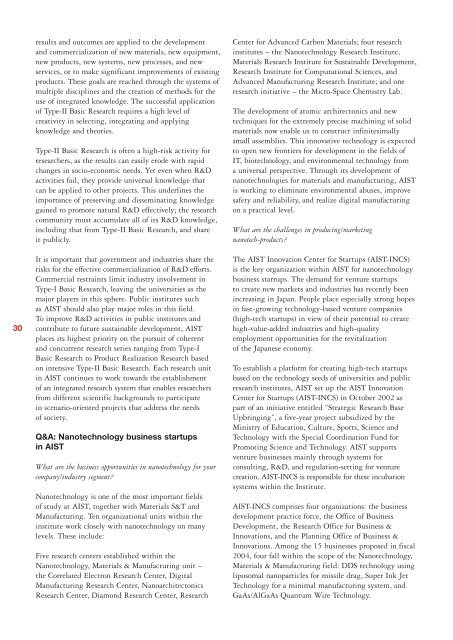Small size - large impact - Nanowerk
Small size - large impact - Nanowerk
Small size - large impact - Nanowerk
You also want an ePaper? Increase the reach of your titles
YUMPU automatically turns print PDFs into web optimized ePapers that Google loves.
30<br />
results and outcomes are applied to the development<br />
and commercialization of new materials, new equipment,<br />
new products, new systems, new processes, and new<br />
services, or to make significant improvements of existing<br />
products. These goals are reached through the systems of<br />
multiple disciplines and the creation of methods for the<br />
use of integrated knowledge. The successful application<br />
of Type-II Basic Research requires a high level of<br />
creativity in selecting, integrating and applying<br />
knowledge and theories.<br />
Type-II Basic Research is often a high-risk activity for<br />
researchers, as the results can easily erode with rapid<br />
changes in socio-economic needs. Yet even when R&D<br />
activities fail, they provide universal knowledge that<br />
can be applied to other projects. This underlines the<br />
importance of preserving and disseminating knowledge<br />
gained to promote natural R&D effectively; the research<br />
community must accumulate all of its R&D knowledge,<br />
including that from Type-II Basic Research, and share<br />
it publicly.<br />
It is important that government and industries share the<br />
risks for the effective commercialization of R&D efforts.<br />
Commercial restraints limit industry involvement in<br />
Type-I Basic Research, leaving the universities as the<br />
major players in this sphere. Public institutes such<br />
as AIST should also play major roles in this field.<br />
To improve R&D activities in public institutes and<br />
contribute to future sustainable development, AIST<br />
places its highest priority on the pursuit of coherent<br />
and concurrent research series ranging from Type-I<br />
Basic Research to Product Realization Research based<br />
on intensive Type-II Basic Research. Each research unit<br />
in AIST continues to work towards the establishment<br />
of an integrated research system that enables researchers<br />
from different scientific backgrounds to participate<br />
in scenario-oriented projects that address the needs<br />
of society.<br />
Q&A: Nanotechnology business startups<br />
in AIST<br />
What are the business opportunities in nanotechnology for your<br />
company/industry segment?<br />
Nanotechnology is one of the most important fields<br />
of study at AIST, together with Materials S&T and<br />
Manufacturing. Ten organizational units within the<br />
institute work closely with nanotechnology on many<br />
levels. These include:<br />
Five research centers established within the<br />
Nanotechnology, Materials & Manufacturing unit –<br />
the Correlated Electron Research Center, Digital<br />
Manufacturing Research Center, Nanoarchitectonics<br />
Research Center, Diamond Research Center, Research<br />
Center for Advanced Carbon Materials; four research<br />
institutes – the Nanotechnology Research Institute,<br />
Materials Research Institute for Sustainable Development,<br />
Research Institute for Computational Sciences, and<br />
Advanced Manufacturing Research Institute; and one<br />
research initiative – the Micro-Space Chemistry Lab.<br />
The development of atomic architectonics and new<br />
techniques for the extremely precise machining of solid<br />
materials now enable us to construct infinitesimally<br />
small assemblies. This innovative technology is expected<br />
to open new frontiers for development in the fields of<br />
IT, biotechnology, and environmental technology from<br />
a universal perspective. Through its development of<br />
nanotechnologies for materials and manufacturing, AIST<br />
is working to eliminate environmental abuses, improve<br />
safety and reliability, and realize digital manufacturing<br />
on a practical level.<br />
What are the challenges in producing/marketing<br />
nanotech-products?<br />
The AIST Innovation Center for Startups (AIST-INCS)<br />
is the key organization within AIST for nanotechnology<br />
business startups. The demand for venture startups<br />
to create new markets and industries has recently been<br />
increasing in Japan. People place especially strong hopes<br />
in fast-growing technology-based venture companies<br />
(high-tech startups) in view of their potential to create<br />
high-value-added industries and high-quality<br />
employment opportunities for the revitalization<br />
of the Japanese economy.<br />
To establish a platform for creating high-tech startups<br />
based on the technology seeds of universities and public<br />
research institutes, AIST set up the AIST Innovation<br />
Center for Startups (AIST-INCS) in October 2002 as<br />
part of an initiative entitled “Strategic Research Base<br />
Upbringing”, a five-year project subsidized by the<br />
Ministry of Education, Culture, Sports, Science and<br />
Technology with the Special Coordination Fund for<br />
Promoting Science and Technology. AIST supports<br />
venture businesses mainly through systems for<br />
consulting, R&D, and regulation-setting for venture<br />
creation. AIST-INCS is responsible for these incubation<br />
systems within the Institute.<br />
AIST-INCS comprises four organizations: the business<br />
development practice force, the Office of Business<br />
Development, the Research Office for Business &<br />
Innovations, and the Planning Office of Business &<br />
Innovations. Among the 15 businesses proposed in fiscal<br />
2004, four fall within the scope of the Nanotechnology,<br />
Materials & Manufacturing field: DDS technology using<br />
liposomal nanoparticles for missile drag, Super Ink Jet<br />
Technology for a minimal manufacturing system, and<br />
GaAs/AlGaAs Quantum Wire Technology.
















